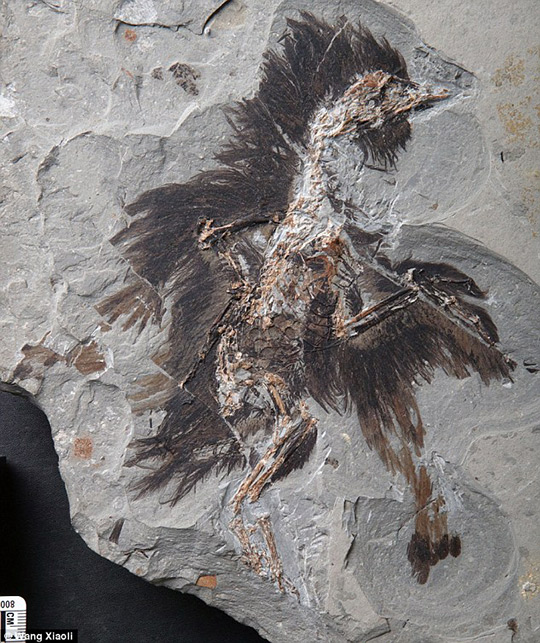

A new breakthrough could enable us to tell what colour dinosaurs were based on their fossils.
Researchers have pinpointed the oldest known example of beta-keratin - a common red-orange pigment - in a 130-million-year-old bird feather fossil.
The fossil of the extinct Eoconfuciusornis bird was collected from the Early Cretaceous lake deposits in Hebei, northern China.

The fossil of the extinct Eoconfuciusornis bird was collected from the Early Cretaceous lake deposits in Hebei, northern China
Feathers and feather-like features of the skin of several types of dinosaurs and basal birds are well documented.
The term 'basal birds' relates to species that are close to the base of the evolutionary chain.
Microbodies associated with these feathers were first interpreted as microbes - single-cell organisms.
However, many scientists now believe that these are actually remnant melanosomes - the part of an animal cell where melanin is synthesised and stored.
Melanin is the most common light-absorbing pigment found in animals and is also responsible for skin colour in humans.

The study could enable us to tell what colour feathered dinosaurs were. Some researchers believe Tyrannosaurus rex even had feathers (illustrated)
Remnant melanosomes could tell us more about the colour, behaviour, habit and physiology of dinosaurs and ancient birds.
However, melanosomes and microbes overlap in size and shape so until now, scientists haven't been able to differentiate between the two in fossilised feathers.
That's why a team of international scientists led by researchers from the Chinese Academy of Sciences set about determining the existence of melanosomes in bird feather fossils.
They used various molecular and chemical methods to pinpoint the melanosomes.

The fossil of the extinct Eoconfuciusornis bird examined in the study was collected from the Early Cretaceous lake deposits in Hebei, northern China
The team applied immunogold - a staining technique used in electron microscopy - to identify proteins.
Their study found fossil evidence of feather structural protein beta-keratin.
'Multiple independent analyses of both microbodies and associated matrix recovered from the fossil feathers confirm that these microbodies are indeed melanosomes,' said Dr. Pan Yanhong from Nanjing Institute of Geology and Palaeontology and corresponding author of the research paper.
The findings could open up the possibility of discovering the true colours of other early birds and dinosaurs by examining the structure of their feathers for pigment proteins.
The research was published in the journal Proceedings of the National Academy of Sciences.
 Fire brigade in Shanghai holds group wedding
Fire brigade in Shanghai holds group wedding Tourists enjoy ice sculptures in Datan Town, north China
Tourists enjoy ice sculptures in Datan Town, north China Sunset scenery of Dayan Pagoda in Xi'an
Sunset scenery of Dayan Pagoda in Xi'an Tourists have fun at scenic spot in Nanlong Town, NW China
Tourists have fun at scenic spot in Nanlong Town, NW China Harbin attracts tourists by making best use of ice in winter
Harbin attracts tourists by making best use of ice in winter In pics: FIS Alpine Ski Women's World Cup Slalom
In pics: FIS Alpine Ski Women's World Cup Slalom Black-necked cranes rest at reservoir in Lhunzhub County, Lhasa
Black-necked cranes rest at reservoir in Lhunzhub County, Lhasa China's FAST telescope will be available to foreign scientists in April
China's FAST telescope will be available to foreign scientists in April "She power" plays indispensable role in poverty alleviation
"She power" plays indispensable role in poverty alleviation Top 10 world news events of People's Daily in 2020
Top 10 world news events of People's Daily in 2020 Top 10 China news events of People's Daily in 2020
Top 10 China news events of People's Daily in 2020 Top 10 media buzzwords of 2020
Top 10 media buzzwords of 2020 Year-ender:10 major tourism stories of 2020
Year-ender:10 major tourism stories of 2020 No interference in Venezuelan issues
No interference in Venezuelan issues
 Biz prepares for trade spat
Biz prepares for trade spat
 Broadcasting Continent
Broadcasting Continent Australia wins Chinese CEOs as US loses
Australia wins Chinese CEOs as US loses